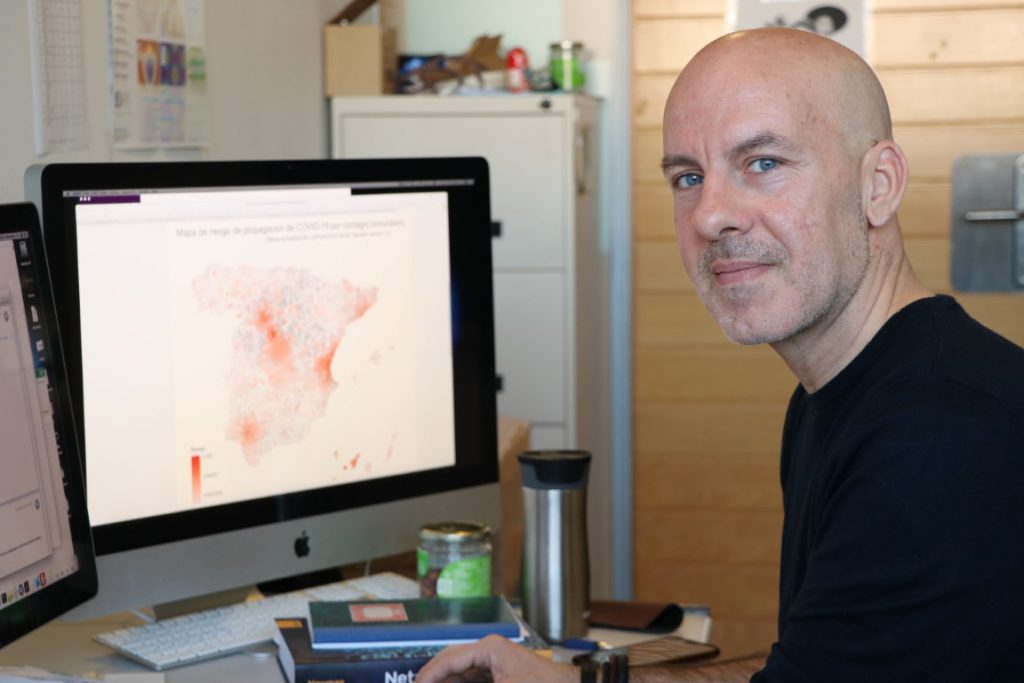Press notes 28/02/2020
A mathematical model predicts the risk of new cases of coronavirus in Spain
Researchers at the Universitat Rovira i Virgili and the Universidad de Zaragoza have developed the tool, which provides its results on a website that is updated daily

Researchers at the Universitat Rovira i Virgili and the Universidad de Zaragoza have developed the tool, which provides its results on a website that is updated daily
In the race against the clock to contain the coronavirus, a group of researchers at the Universitat Rovira i Virgili and the Universidad de Zaragoza have developed a mathematical model that can predict the risk of new cases in municipalities throughout Spain. With this new tool, researchers want to anticipate the spread of COVID-19 and so that effective measures can be put in place to control it. One of the characteristics of the model is that it takes into account the spread of the virus by people who do not show any symptoms, which has been one of the main obstacles to controlling the expansion of the disease. The results of the research have been used to create a map that is updated daily on the website http://deim.urv.cat/~alephsys/COVID-19/.
This group of researchers has been working for many years on developing mathematical models to study the spread of epidemics using patterns of movement and censuses of affected areas. “We have now adapted one of these models to COVID-19 by including the epidemiological data obtained so far about the virus and the influence of asymptomatic individuals who may cause new cases”, explained Alex Arenas, from the Alephsys Lab research group (URV). By using data on people’s movements between Spanish towns and cities (from the National Institute of Statistics) researchers have developed this tool to show the estimated risk of an epidemic in Spanish municipalities. “The model can be transferred easily to other countries that also gather similar data”, Arenas stated.
One of the challenges posed by the coronavirus has been to predict and quantify new cases of unknown origin on a national scale. Cases of unknown origin are when a person becomes infected by the virus but it is not known what the source of the infection is because they have no recent history of travelling to affected areas or of contact with other known infected individuals. COVID-19 is characterised by a very long asymptomatic epidemic state (or one with light or moderate symptoms) that can be up to 14 days long according to the data obtained so far. This makes the early detection, isolation and medical treatment of cases difficult.
According to recent epidemiological studies, it is likely that during part of this asymptomatic period infected individuals may spread the pathogen without any warning signs. “This severely complicates efforts to trace possible secondary cases caused by people confirmed as having the virus”, explained Jesús Gómez-Gardeñes, researcher from the Universidad de Zaragoza. This silent expansion of the virus beyond the immediate radius of activity of detected cases makes it very difficult to detect infection hotspots. “This helps the spread of the virus and hinders the implementation of effective measures of control, especially when these are based exclusively on localised quarantine in areas where cases have been confirmed”, added Sergio Gómez, researcher at the URV.

To anticipate this chain of silent infections, the researchers believe it is crucial to take into account not just the contagion patterns of COVID-19 but also the regular movements of people between different areas, because this is how the virus can spread yet further. “People’s movements are very important when the normal period of infectivity in asymptomatic individuals is long, because they directly increase the range of expansion”, according to Clara Granell, researcher at the Universidad de Zaragoza.
The mathematical model that this group of researchers has been working on for weeks takes into account the epidemiological parameters known to date and it will also include the possible variations that may be found in future studies. “This algorithm can incorporate new results and work with up-to-date data at all times”, commented Benjamin Steinegger, researcher at the URV.
Another advantage of this algorithm is that it can take into account data from quarantine zones, “which means that its efficacy can be evaluated in relation to the isolated areas”, stated David Soriano, researcher at the Universidad de Zaragoza.
The researchers warn, however, that the model is still unable to predict cases that come from outside the country and neither can it take into account that the mobility data its uses may change, as would be the case if, for example, mobility between certain areas was restricted.
